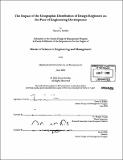The impact of the geographic distribution of design engineers on the pace of engineering development
Author(s)
Schiller, David (David Andrew), 1975-
DownloadFull printable version (8.459Mb)
Other Contributors
System Design and Management Program.
Advisor
Ricardo Valerdi.
Terms of use
Metadata
Show full item recordAbstract
The increasing use of digital design tools and broadband information networks is creating an environment that permits the geographic distribution of design engineers. In order to successfully distributed engineering the consequences need to be understood. Through the examination of records of project execution, this thesis investigates whether the decision to geographically distribute engineers has a measurable impact on the pace of engineering development. A task-based Design Structure Matrix (DSM) was developed and showed that the projects studied were developed using a highly integral process. It is hypothesized the unanticipated consequences of distributing engineers geographically will slow the pace of engineering development to such an extent that costs incurred in protracted engineering development outweigh the benefits. (cont.) Three findings result from of this study. First, the geographic distribution of design engineers proved to have a negative affect on schedule performance causing distributed projects to overrun their schedules by more than twice as much as localized projects. Second, the development process for the systems studied was found to be highly iterative rather than adhering to the anticipated waterfall model espoused by the process documentation. Third, the level of task aggregation used to study this phenomenon affects the ability to identify the impact of distributed engineering.
Description
Thesis (S.M.)--Massachusetts Institute of Technology, System Design and Management Program, 2006. Includes bibliographical references (p. 69-70).
Date issued
2006Department
System Design and Management Program.Publisher
Massachusetts Institute of Technology
Keywords
System Design and Management Program.